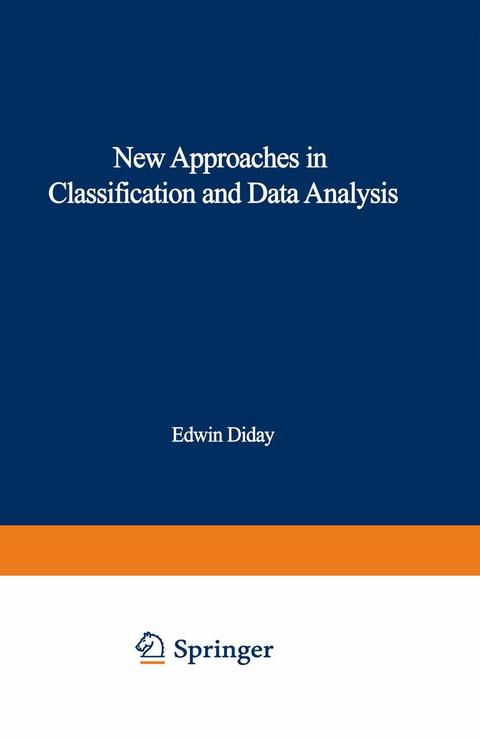
New Approaches in Classification and Data Analysis
Springer Berlin (Verlag)
978-3-540-58425-4 (ISBN)
Classification and Clustering: Problems for the Future.- From classifications to cognitive categorization: the example of the road lexicon.- A review of graphical methods in Japan-from histogram to dynamic display.- New Data and New Tools: A Hypermedia Environment for Navigating Statistical Knowledge in Data Science.- On the logical necessity and priority of a monothetic conception of class, and on the consequent inadequacy of polythetic accounts of category and categorization.- Research and Applications of Quantification Methods in East Asian Countries.- Algorithms for a geometrical P.C.A. with the L1-norm.- Comparison of hierarchical classifications.- On quadripolar Robinson dissimilarity matrices.- An Ordered Set Approach to Neutral Consensus Functions.- From Apresjan Hierarchies and Bandelt-Dress Weak hierarchies to Quasi-hierarchies.- Spanning trees and average linkage clustering.- Adjustments of tree metrics based on minimum spanning trees.- The complexity of the median procedure for binary trees.- A multivariate analysis of a series of variety trials with special reference to classification of varieties.- Quality control of mixture. Application: The grass.- Mixture Analysis with Noisy Data.- Locally optimal tests on spatial clustering.- Choosing the Number of Clusters, Subset Selection of Variables, and Outlier Detection in the Standard Mixture-Model Cluster Analysis.- An examination of procedures for determining the number of clusters in a data set.- The gap test: an optimal method for determining the number of natural classes in cluster analysis.- Mode detection and valley seeking by binary morphological analysis of connectivity for pattern classification.- Interactive Class Classification Using Types.- K-means clustering in a low-dimensional Euclideanspace.- Complexity relaxation of dynamic programming for cluster analysis.- Partitioning Problems in Cluster Analysis: A Review of Mathematical Programming Approaches.- Clusters and factors: neural algorithms for a novel representation of huge and highly multidimensional data sets.- Graphs and structural similarities.- A generalisation of the diameter criterion for clustering.- Percolation and multimodal data structuring.- Classification and Discrimination Techniques Applied to the Early Detection of Business Failure.- Recursive Partition and Symbolic Data Analysis.- Interpretation Tools For Generalized Discriminant Analysis.- Inference about rejected cases in discriminant analysis.- Structure Learning of Bayesian Networks by Genetic Algorithms.- On the representation of observational data used for classification and identification of natural objects.- Alternative strategies and CATANOVA testing in two-stage binary segmentation.- Alignment, Comparison and Consensus of Molecular Sequences.- An Empirical Evaluation of Consensus Rules for Molecular Sequences.- A Probabilistic Approach To Identifying Consensus In Molecular Sequences.- Applications of Distance Geometry to Molecular Conformation.- Classification of aligned biological sequences.- Use of Pyramids in Symbolic Data Analysis.- Proximity Coefficients between Boolean symbolic objects.- Conceptual Clustering in Structured Domains: A Theory Guided Approach.- Automatic Aid to Symbolic Cluster Interpretation.- Symbolic Clustering Algorithms using Similarity and Dissimilarity Measures.- Feature Selection for Symbolic Data Classification.- Towards extraction method of knowledge founded by symbolic objects.- One Method of Classification based on an Analysis of the Structural Relationship between Independent Variables.- The Integration of Neural Networks with Symbolic Knowledge Processing.- Ordering of Fuzzy k-Partitions.- On the Extension of Probability Theory and Statistics to the Handling of Fuzzy Data.- Fuzzy Regression.- Clustering and Aggregation of Fuzzy Preference Data: Agreement vs. Information.- Rough Classification with Valued Closeness Relation.- Representing proximities by network models.- An Eigenvector Algorithm to Fit lp-Distance Matrices.- A non linear approach to Non Symmetrical Data Analysis.- An Algorithmic Approach to Bilinear Models for Two-Way Contingency Tables.- New Approaches Based on Rankings in Sensory Evaluation.- Estimating failure times distributions from censored systems arranged in series.- Calibration Used as a Nonresponse Adjustment.- Least Squares Smoothers and Additive Decomposition.- High Dimensional Representations and Information Retrieval.- Experiments of Textual Data Analysis at Electricité de France.- Conception of a Data Supervisor in the Prospect of Piloting Management Quality of Service and Marketing.- Discriminant Analysis Using Textual Data.- Recent Developments in Case Based Reasoning: Improvements of Similarity Measures.- Contiguity in discriminant factorial analysis for image clustering.- Exploratory and Confirmatory Discrete Multivariate Analysis in a Probabilistic Approach for Studying the Regional Distribution of Aids in Angola.- Factor Analysis of Medical Image Sequences (FAMIS): Fundamental principles and applications.- Multifractal Segmentation of Medical Images.- The Human Organism-a Place to Thrive for the Immuno-Deficiency Virus.- Comparability and usefulness of newer and classical data analysis techniques. Application in medical domain classification.- The Classification of IRAS Point Sources.- Astronomical classification ofthe Hipparcos input catalogue.- Group identification and individual assignation of stars from kinematical and luminosity parameters.- Specific numerical and symbolic analysis of chronological series in view to classification of long period variable stars.- Author and Subject Index.
| Erscheint lt. Verlag | 10.11.1994 |
|---|---|
| Reihe/Serie | Studies in Classification, Data Analysis, and Knowledge Organization |
| Zusatzinfo | XII, 693 p. |
| Verlagsort | Berlin |
| Sprache | englisch |
| Maße | 140 x 216 mm |
| Gewicht | 1155 g |
| Themenwelt | Mathematik / Informatik ► Mathematik |
| Wirtschaft ► Volkswirtschaftslehre ► Ökonometrie | |
| Schlagworte | ANOVA • best fit • classification • Cluster-Analyse • cluster analysis • Clustering • clustering algorithm • Data Analysis • Datenanalyse • Factor Analysis • Klassifikation • Knowledge-based systems • Median • Probability Theory • Wissensbasierte Systeme |
| ISBN-10 | 3-540-58425-0 / 3540584250 |
| ISBN-13 | 978-3-540-58425-4 / 9783540584254 |
| Zustand | Neuware |
| Haben Sie eine Frage zum Produkt? |
aus dem Bereich


